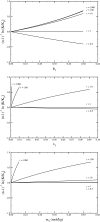Kirkwood-Buff theory of molecular and protein association, aggregation, and cellular crowding
- PMID: 19894976
- PMCID: PMC2780464
- DOI: 10.1063/1.3253299
Kirkwood-Buff theory of molecular and protein association, aggregation, and cellular crowding
Abstract
An analysis of the effect of a cosolvent on the association of a solute in solution using the Kirkwood-Buff theory of solutions is presented. The approach builds on the previous results of Ben-Naim by extending the range of applicability to include any number of components at finite concentrations in both closed and semiopen systems. The derived expressions, which are exact, provide a foundation for the analysis and rationalization of cosolvent effects on molecular and biomolecular equilibria including protein association, aggregation, and cellular crowding. A slightly different view of cellular crowding is subsequently obtained. In particular, it is observed that the addition of large cosolvents still favors the associated form even when traditional excluded volume effects are absent.
Figures


Similar articles
-
The Kirkwood-Buff theory and the effect of cosolvents on biochemical reactions.J Chem Phys. 2004 Nov 8;121(18):9147-55. doi: 10.1063/1.1806402. J Chem Phys. 2004. PMID: 15527383
-
Chemical potential derivatives and preferential interaction parameters in biological systems from Kirkwood-Buff theory.Biophys J. 2006 Aug 1;91(3):849-56. doi: 10.1529/biophysj.105.078790. Epub 2006 May 5. Biophys J. 2006. PMID: 16679363 Free PMC article.
-
On the theory of solute solubility in mixed solvents.J Phys Chem B. 2008 Jul 3;112(26):7875-84. doi: 10.1021/jp712179w. Epub 2008 Jun 5. J Phys Chem B. 2008. PMID: 18529024 Free PMC article.
-
Molecular basis of osmolyte effects on protein and metabolites.Methods Enzymol. 2007;428:459-86. doi: 10.1016/S0076-6879(07)28026-7. Methods Enzymol. 2007. PMID: 17875434 Review.
-
Crowders and Cosolvents-Major Contributors to the Cellular Milieu and Efficient Means to Counteract Environmental Stresses.Chemphyschem. 2017 Nov 3;18(21):2951-2972. doi: 10.1002/cphc.201700762. Epub 2017 Sep 27. Chemphyschem. 2017. PMID: 28810057 Review.
Cited by
-
Reaching new levels of realism in modeling biological macromolecules in cellular environments.J Mol Graph Model. 2013 Sep;45:144-56. doi: 10.1016/j.jmgm.2013.08.017. Epub 2013 Aug 28. J Mol Graph Model. 2013. PMID: 24036504 Free PMC article. Review.
-
Salt Effects on Caffeine across Concentration Regimes.J Phys Chem B. 2023 Dec 7;127(48):10253-10265. doi: 10.1021/acs.jpcb.3c01085. Epub 2023 Nov 21. J Phys Chem B. 2023. PMID: 38058160 Free PMC article.
-
CVM-1118 (foslinanib), a 2-phenyl-4-quinolone derivative, promotes apoptosis and inhibits vasculogenic mimicry via targeting TRAP1.Pathol Oncol Res. 2023 Jun 7;29:1611038. doi: 10.3389/pore.2023.1611038. eCollection 2023. Pathol Oncol Res. 2023. PMID: 37351538 Free PMC article.
-
Power-law dependence of the melting temperature of ubiquitin on the volume fraction of macromolecular crowders.J Chem Phys. 2011 Mar 7;134(9):095104. doi: 10.1063/1.3556671. J Chem Phys. 2011. PMID: 21385002 Free PMC article.
-
Kirkwood-Buff integrals for ideal solutions.J Chem Phys. 2010 Apr 28;132(16):164501. doi: 10.1063/1.3398466. J Chem Phys. 2010. PMID: 20441282 Free PMC article.
References
Publication types
MeSH terms
Substances
Grants and funding
LinkOut - more resources
Full Text Sources

